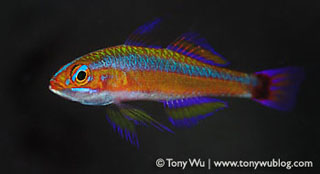 There's a small town in New South Wales named Narromine. I've never been there, probably will never have a chance to visit. From what I understand, it's not a particularly special town. As of a 2001 census, Narromine had a population of 3,548 people. It's known for growing citrus fruits and is popular among gliding enthusiasts.
There's a small town in New South Wales named Narromine. I've never been there, probably will never have a chance to visit. From what I understand, it's not a particularly special town. As of a 2001 census, Narromine had a population of 3,548 people. It's known for growing citrus fruits and is popular among gliding enthusiasts.
As unremarkable a place as this little town might seem, I learned something about Narromine on my recent trip to Papua New Guinea that means I'm highly unlikely ever to forget the place, and I'd probably jump at the opportunity to go there if the occasion ever arises.
Here's the story: Apparently, if you stir the air with your finger in a clockwise (to account for the Coriolis effect) direction while you're in Narrowmine, it's possible to start a small willy willy (that's Aussie-speak for little tornado). I imagine that this works best if you pick an area with black pavement or other such similar surface to ensure maximum amounts of rising hot air, but in any case, when I heard this from Tim, one of my fellow passengers on the MV Golden Dawn, I immediately pictured myself spending hours and hours in the arid climate, snickering like the proverbial mad scientist while stirring the air to conjure up a bunch of little willy willies.
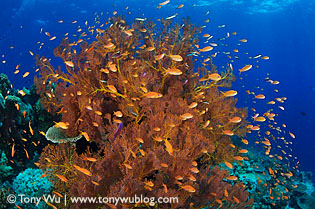 I could see myself doing this for days without getting bored, wondering all the while whether my creation of little wind dervishes would lead to unforeseen and catastrophic effects in far-flung corners of the world...a disastrous derivative of the Butterfly Effect.
I could see myself doing this for days without getting bored, wondering all the while whether my creation of little wind dervishes would lead to unforeseen and catastrophic effects in far-flung corners of the world...a disastrous derivative of the Butterfly Effect.
Though it might not seem obvious, this bit of trivia has a lot to do with diving, or rather, the absence thereof. To cut to the chase, the weather was less-than-cooperative during my month in PNG.
Mainly it was the wind, with 25-30 knot winds the norm, and gusts up to 50 knots on some days. In practical terms, this meant that it was tough to reach some dive sites while I was based at Loloata, and we were port-bound for a few days of the scheduled trip to Eastern Fields on Golden Dawn.
With ample time on hand to chat with fellow travellers, I found myself eagerly accumulating bits of trivia (a fancy word for "almost entirely useless information") and pondering things that I'd probably never otherwise contemplate (since I'd normally have more productive things to do).
Holiday Sacrifice
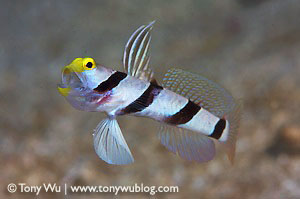 I flew to PNG on 22 December, meaning that I missed both Christmas and New Year. The holidays per se don't mean much to me, but I really like the time of year in Japan, since everything shuts down and the entire country becomes quiet, still, peaceful.
I flew to PNG on 22 December, meaning that I missed both Christmas and New Year. The holidays per se don't mean much to me, but I really like the time of year in Japan, since everything shuts down and the entire country becomes quiet, still, peaceful.
The hustle and bustle of normal life in and around Tokyo grinds to a nearly complete halt, and in many ways, it's one of the most sane times of year in the hectic metropolis. People spend time with their families and friends, and you can almost feel the collective sigh of relief as everyone takes a well-deserved and much-needed break. I particularly enjoy the new year traditions (see my posts from the previous year: one, two, three)
Anyway, it takes a lot to pull me away during this season, and PNG is one of the flew places I'd sacrifice the holidays for. The reason is simple...the underwater sights are awesome. More on that in a bit.
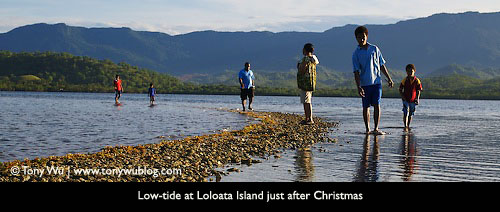 As it turned out, Christmas Eve and the actual day passed by without much fanfare, as we were all too busy and tuckered out from diving, and I spent a quiet and pleasant New Year's Eve on the balcony of a friend's apartment sipping a glass of Chardonnay while enjoying the sunset over Port Moresby harbour.
As it turned out, Christmas Eve and the actual day passed by without much fanfare, as we were all too busy and tuckered out from diving, and I spent a quiet and pleasant New Year's Eve on the balcony of a friend's apartment sipping a glass of Chardonnay while enjoying the sunset over Port Moresby harbour.
Diving Port Moresby
Many cities are located on the water, but most of the time, you wouldn't want to dive in those waters. This might change with time, but for the present, the waters around Port Moresby are an exception...the area is teeming with life.
The signature dive site around Port Moresby is Suzie's Bommie. You've probably seen it featured in articles in various dive magazines, so I won't dwell on a description of the site or on trying to think of an appropriate string of superlatives.
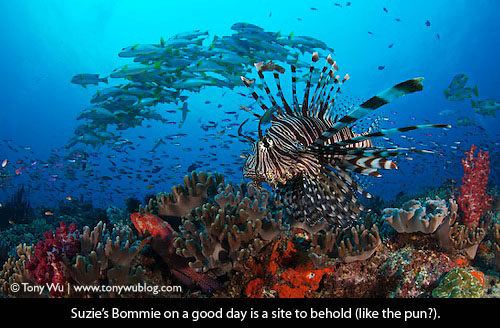 Suffice it to say that this relatively small bommie holds its own against most dive sites around the world, and you'll definitely want to pay it a visit if you find yourself in the area, weather permitting of course. The site is a 25-minute boat ride away from the inside of Bootless Bay (where Loloata Island Resort is, and where other day boats generally depart from), so when the winds are ripping and/ or the swells are acting up, it may not be safe to go there.
Suffice it to say that this relatively small bommie holds its own against most dive sites around the world, and you'll definitely want to pay it a visit if you find yourself in the area, weather permitting of course. The site is a 25-minute boat ride away from the inside of Bootless Bay (where Loloata Island Resort is, and where other day boats generally depart from), so when the winds are ripping and/ or the swells are acting up, it may not be safe to go there.
The dive guides told me stories of divers insisting on visiting Suzie's when conditions were unsafe, in some cases to disastrous consequence. Maybe it's just me, but I tend to pay heed to local knowledge and experience. When the guides thought going to Suzie's wasn't a good idea, we didn't go. Pretty simple concept, but it's odd how some people seem to think they know better.
One thing that makes these waters highly unusual is the abundance of lacy scorpionfish (Rhinopias aphanes), a fish that seems to be rare in most other locations (or perhaps just highly difficult to spot). For many divers, especially photographers, the reasonably high probability (note: not guarantee) of seeing one or more of these fish is reason enough to dive around Port Moresby. During my stay, we located approximately 10 individuals, covering a range of sizes and colours.
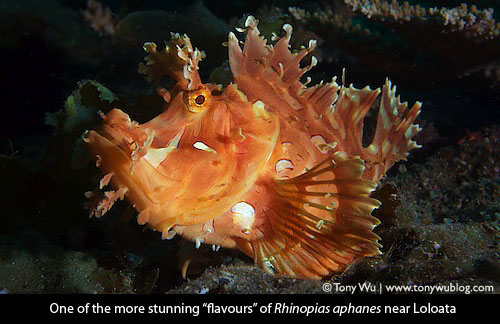 What precisely makes these cryptic fish congregate on the reefs around Moresby is a mystery, though that's not surprising given how little is known about them in general. One thing I did learn is that the Rhinopias in this area are most likely all the aphanes species, not the frondosa or other species.
What precisely makes these cryptic fish congregate on the reefs around Moresby is a mystery, though that's not surprising given how little is known about them in general. One thing I did learn is that the Rhinopias in this area are most likely all the aphanes species, not the frondosa or other species.
There is considerable confusion, misinformation, and mixing of terms on the internet and in dive publications regarding the aphanes and frondosa species. I'm hard-pressed to provide an easy way to tell the difference (actually, I'm not sure anyone can do so accurately just by sight), but one thing that Dik Knight, who owns and manages Loloata explained to me is that both fish occupy the same ecological niche, so they are highly unlikely to co-habit the same area.
Makes sense to me, but I will undoubtedly continue to remain confused each time I see one of these exquisite critters, irrespective of the species.
One final point about this area...if you find yourself there at a time of low visibility (which happens from time to time because of the high nutrient flow from nearby major river systems), go with the flow and don't stress too much about seeing the big stuff.
The concentration of macro life subjects in incredible, and no matter what the conditions, there's always something to see and learn. Nearby Lion Island is generally the place to go diving when conditions are less than optimal. Viz isn't terrific, and there generally aren't large animals swimming by, but if you look closely, there are all sorts of interesting finds. I never have a problem keeping myself amused for hours around Lion Island.
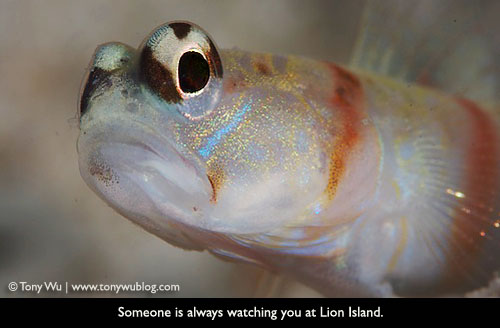 Among some of my finds this time: curious blennies peeking around corners to observe me, a juvenile Amblyeleotris guttata goby (normally difficult to approach), a possible Tomiyamichthys oni goby (but with slightly different markings and exhibiting unusual behaviour), four Phyllodesmium longicirrum solar-powered nudibranchs, and a whole host of other stuff.
Among some of my finds this time: curious blennies peeking around corners to observe me, a juvenile Amblyeleotris guttata goby (normally difficult to approach), a possible Tomiyamichthys oni goby (but with slightly different markings and exhibiting unusual behaviour), four Phyllodesmium longicirrum solar-powered nudibranchs, and a whole host of other stuff.
Um Or Ium?
Besides the wonderful tidbit about Narromine, I also picked up a few other choice factoids that I can now throw out at parties to make everyone wonder what I do with my time. Among the more memorable items:
- Borscht is not Russian. It's Ukranian.
- Chewbacca's voice/ sound is based on the sounds George Lucas' pet malamute made.
- The breed standard weight for malamutes is about 45 kgs.
- Banksia plants (and apparently quite a few others) require brush fires for their seeds to germinate.
- English/ UK law was originally written in an archaic form of French, on the theory that an archaic language does not change, while living languages do.
- The etymology for the word "posh" comes from when ships sailed from the UK to then-colony India. It is an acronym for Port Out, Starboard Home, which describes the cabins that wealthier people preferred because of relatively greater comfort given prevailing wind conditions.
- The world's helium supply is mined and therefore limited. Most of it used to be mined in the USA, but now comes primarily from Russia.
- If you have a helium-filled balloon in a car and you accelerate, it will go forward. If you brake it will go backward. (You gotta think about this one for a moment to get it.)
- Aluminium melts without turning orange first, making it quite difficult to weld properly.
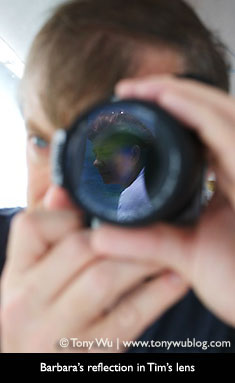 Credit for most of these odds and ends goes to fellow Golden Dawn passengers Tim and Barbara, a seemingly inexhaustible source of superfluous information and otherwise highly engaging people.
Credit for most of these odds and ends goes to fellow Golden Dawn passengers Tim and Barbara, a seemingly inexhaustible source of superfluous information and otherwise highly engaging people.
Speaking of Tim, the point about aluminium engendered a debate between Tim and someone else (can't recall precisely whom) about whether "aluminium" or "aluminum" is correct. Tim originally hails from the UK, which explains his preference for the "-ium" ending. His reasoning was that no other element in the periodic table ends in "ium", thus demonstrating the US corruption of the English language.
Though I could care less either way, I pointed out that molybdenum ends in "-um" (I have no idea why or how I knew that. Must have been from another period of accumulating useless information), which sort of put a hole in the hull of that argument. Subsequently, I thought of "platinum" and then found another on the net, "lanthanum"...so Tim, that's three!
[Note: Received an email letting me know that aluminium is difficult to weld because it oxidizes too rapidly to achieve a good joint, so you need to use an electric arc weld in a bubble of insert gas like argon, fed in from a tank. Cool.]
A Bit About The Eastern Fields
 Anyone who knows me has probably heard me rant and rave about the Eastern Fields. It's just awesome. What makes it so amazing is its remote location. Situated halfway to Australia, the Eastern Fields is a system of submerged atolls that are part of PNG territory, extending about 15 x 25 km in size, 100 metres or so in depth inside the atoll and dropping to 2000+ metres outside.
Anyone who knows me has probably heard me rant and rave about the Eastern Fields. It's just awesome. What makes it so amazing is its remote location. Situated halfway to Australia, the Eastern Fields is a system of submerged atolls that are part of PNG territory, extending about 15 x 25 km in size, 100 metres or so in depth inside the atoll and dropping to 2000+ metres outside.
The area is not well marked on charts, and weather is difficult for most of the year, so the Golden Dawn is the only boat that regularly visits. The lack of pressure from people means that the reefs are truly pristine, and fish number in the gazillions. Visibility is almost always excellent, and you'll not likely to run into anyone else out there. In all of human history, only a few hundred people have ever dived the Eastern Fields.
So it kind of sucked when gale-force winds kept us from heading out there for a few days.
To make a long story short, we spent much of the first four days of the 10-day trip downloading weather forecasts (notoriously unreliable for such a remote area) and making several aborted attempts to make the 12-hour ocean crossing. Each time, we ended up back in or near Moresby, diving in low-visibility waters or just sitting on the boat.
 The saving grace was the passengers. It's no exaggeration to say that my co-travellers were among the best group of people I've ever spent time with on a boat, particularly given the climatological circumstances.
The saving grace was the passengers. It's no exaggeration to say that my co-travellers were among the best group of people I've ever spent time with on a boat, particularly given the climatological circumstances.
If you've ever been on an extended liveaboard trip, you know that the people make or break the trip, and one bad apple truly spoils the lot. Reality TV has nothing on the politics and drama on a liveaboard with unpleasant people aboard.
So it's always with some wariness that I size-up fellow travellers on long cruises. The roster this time included Tim and Barbara (from Australia, but Tim originally from the UK), Ai Lin (friend from Singapore), Marcus (from Singapore but originally Malaysia), Stephane (from France), Obata-san (from Japan) and Antonio and Gunita (Antonio is half German, half Sicilian, making for quite an entertaining personality, and Gunita is the first person from Latvia I've ever met).
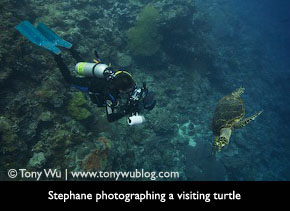 In less-than-ideal circumstances, everyone was totally cool, and we had a great time, even while we remained confined to port. Jokes, games, serious chats, trading of useless facts...I'd happily travel with any of them again. Truly amazing was Obata-san, who though unable to speak much English, had not one iota of difficulty communicating with everyone, and even had the crew and some passengers spouting off Japanese by the end of the trip.
In less-than-ideal circumstances, everyone was totally cool, and we had a great time, even while we remained confined to port. Jokes, games, serious chats, trading of useless facts...I'd happily travel with any of them again. Truly amazing was Obata-san, who though unable to speak much English, had not one iota of difficulty communicating with everyone, and even had the crew and some passengers spouting off Japanese by the end of the trip.
When the winds settled a bit and we did finally make it out to Eastern Fields, the diving didn't disappoint. With no land nearby, the visibility was great, waters blue, and marine life abundant. We still had to contend with strong winds, and as a result weren't able to get to many of my favourite sites, but any dive in the Eastern Fields is special.
The best dives, for me at least, came on our last day out there, when we visited a small reef called Carl's Ultimate, named for my friend Carl Roessler. The term "ultimate" hardly does the reef justice.
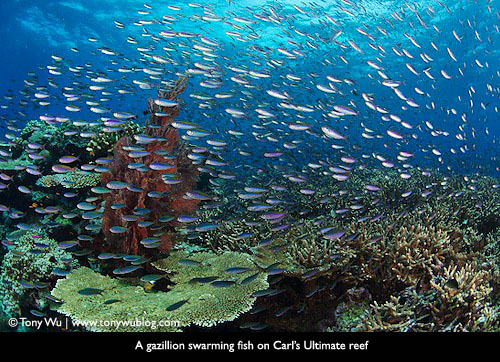 Elongated and easily swimmable, the reef is one of the most action-packed dives you'll ever encounter. Of course, you've got to hit it when the current is running, as the elongated shape of the reef means there are effectively two tips, both of which serve as centres of activity when the current is whipping past. When the current is slack, it's much easier to swim around, but the action isn't anywhere near as adrenalin-charged.
Elongated and easily swimmable, the reef is one of the most action-packed dives you'll ever encounter. Of course, you've got to hit it when the current is running, as the elongated shape of the reef means there are effectively two tips, both of which serve as centres of activity when the current is whipping past. When the current is slack, it's much easier to swim around, but the action isn't anywhere near as adrenalin-charged.
Large sea fans, super-gazillions of fish, large predators like barracuda, dogtooth tuna and trevallies, and large resident potato cods (who unfortunately were away during most of our day there)...if I had to pick just one site to dive in the Eastern Fields, this would be it. During our final day, we had excellent weather and I spent 6.5 hours on the reef, happily observing the goings on and taking the occasional photograph (slight understatement).
Not All Sugar and Honey
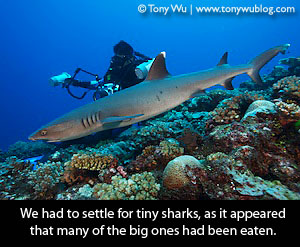 Life isn't a fairy tale of course, so there was an unhappy side to this visit...the number of sharks was far too low. Craig, Golden Dawn's captain, had warned me in advance that fishing fleets, most likely from Asia, had swooped in and pillaged the atolls a few times, but I still really wasn't quite prepared for the shock.
Life isn't a fairy tale of course, so there was an unhappy side to this visit...the number of sharks was far too low. Craig, Golden Dawn's captain, had warned me in advance that fishing fleets, most likely from Asia, had swooped in and pillaged the atolls a few times, but I still really wasn't quite prepared for the shock.
This is the place where I've been surrounded by silvertips, swam next to hammerheads, been nearly engulfed in swarms of friendly reef whitetips, and been mesmerised by legions of patrolling grey reefs. No longer.
I hesitate to pronounce judgement after just this trip, but dammit...can't humans just stop being so f*cking stupid? Seriously, the Eastern Fields is not an easy place to reach, and it's far from safe for fishing vessels. This kept the fleets away for many years, but it must be a sign of how dry the well is running elsewhere and how voracious the collective Asian appetite for shark fin is that fishing vessels were prepared to take the considerable risk of hitting one of the many unmarked bommies for the sake of reaping quick profits from shark fins.
I wanted to get angry, but a deep, dark vacuum in my gut prevailed, sucking the life out of me after we came up empty handed from our first shark dive...leaving me utterly despondent.
Everyone on board wanted to see sharks, and we managed to stir up a couple of silvertips and some teeny whitetip reef sharks plus a few really, really small grey reefs, but sigh...
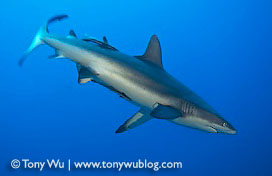 Demolishing shark populations for their fins is but a symptom of a much greater problem. Overfishing is rapidly depleting the world's oceans of fish. Governments around the world are using tax funds to subsidise ever-larger fleets to kill ever-more fish in ever-more efficient (read unsustainable) ways. It's not just Asian fishing boats. European boats are among the world's worst offenders in this regard. It's a global problem, but remains largely hidden from public view and awareness.
Demolishing shark populations for their fins is but a symptom of a much greater problem. Overfishing is rapidly depleting the world's oceans of fish. Governments around the world are using tax funds to subsidise ever-larger fleets to kill ever-more fish in ever-more efficient (read unsustainable) ways. It's not just Asian fishing boats. European boats are among the world's worst offenders in this regard. It's a global problem, but remains largely hidden from public view and awareness.
To be witnessing this directly is one of the saddest things I'm sure I'll ever experience.
Look Ma, No Bubbles
 Going back to less disheartening stuff...one of the best things about being on Golden Dawn was having the chance to dive on a rebreather again. Craig certified me on a KISS rebreather several years ago. It had been a while since I'd dived the unit, so it took a bit of getting reacquainted, but two dives or so and I was back in good form.
Going back to less disheartening stuff...one of the best things about being on Golden Dawn was having the chance to dive on a rebreather again. Craig certified me on a KISS rebreather several years ago. It had been a while since I'd dived the unit, so it took a bit of getting reacquainted, but two dives or so and I was back in good form.
Diving on a fully closed-circuit rebreather has its pros and cons. I'm by means no expert on the ins and outs of rebreathers, but for me, the biggest advantage is gaining extra time safely at normal scuba depths. By maintaining a relatively conservative PPO2 of 1.00, at normal scuba depths you're getting relatively high levels of O2 without taking undue risk of O2 toxicity, meaning quicker flushing of nitrogen out of your system.
For someone like me who likes to sit with a fish at 12 metres for an hour or more, this is an incredible boon. I'm generally much less tired than from breathing air, and with the gases I'm breathing being recycled, the chances of running low on gas are...low.
 Other benefits include staying warm (because you're not exhaling air and expelling body heat), as well as the fact that you don't blow a lot of bubbles. It's a mistake to think you're completely bubble-less, but you're not scaring fish halfway to oblivion each time you exhale.
Other benefits include staying warm (because you're not exhaling air and expelling body heat), as well as the fact that you don't blow a lot of bubbles. It's a mistake to think you're completely bubble-less, but you're not scaring fish halfway to oblivion each time you exhale.
Cons include the need to be much more vigilant and aware of your equipment and gas levels, having to spend time maintaining the rebreather (as if camera gear weren't hassle enough), and having to grow accustomed to the constrictive feeling of breathing into a bag (which is effectively what a closed-circuit rebreather is...you blowing into and breathing out of a bag).
Overall, the KISS system is really simple to use (KISS stands for Keep It Simple, Stupid), but as with any life-support system, there are risks involved, so it's not for everyone.
 Fellow passenger Marcus brought along his own Megalodon fully-closed rebreather system, brand-spanking new, so I had someone else going bubble-less with me, which was a comforting feeling. When you're down for two to three hours and you're in stealth mode not blowing bubbles, it can get a bit lonely, and just the knowledge that someone else is down with you is a great psychological boost.
Fellow passenger Marcus brought along his own Megalodon fully-closed rebreather system, brand-spanking new, so I had someone else going bubble-less with me, which was a comforting feeling. When you're down for two to three hours and you're in stealth mode not blowing bubbles, it can get a bit lonely, and just the knowledge that someone else is down with you is a great psychological boost.
Marcus also had an iPhone with him, a Mac laptop, a Seacam housing and other toys, making him officially a member of the global gadget geek brigade. It also made him really easy to pick out at the airport, as his baggage trolley was practically pleading for help under the weight of his luggage.
Soft Spot
Continuing my ongoing efforts toward creativity, I devoted some time while diving around Port Moresby to shooting at the f2.8 to f4 range instead of selecting the smaller f-stops more generally used by marine photographers.
 I had two reasons for this. The first was practical. With relatively low visibility, once of the side effects of using a small f-stop for clarity is that you see everything clearly, including all the stuff you don't want to see clearly...gunk in the water.
I had two reasons for this. The first was practical. With relatively low visibility, once of the side effects of using a small f-stop for clarity is that you see everything clearly, including all the stuff you don't want to see clearly...gunk in the water.
By opening up, you can take advantage of the blurry/ dreamy effect that results to minimise distraction caused by particles in the water. The attendant difficulty, of course, is that your depth of field is severely restricted, and it's a heckuva lot more difficult to get pinpoint sharpness where you want.
The second was just a matter of creativity. Some subjects just seem to work better as "soft and cuddly", irrespective of whether the actual subjects are like that in real life or not. I generally don't photograph for the purpose of getting ID photos, so I'm not terribly concerned with accurately representing the real life situation.
I prefer to watch an animal, consider how it might be portrayed in a flattering or unusual manner, and work accordingly.
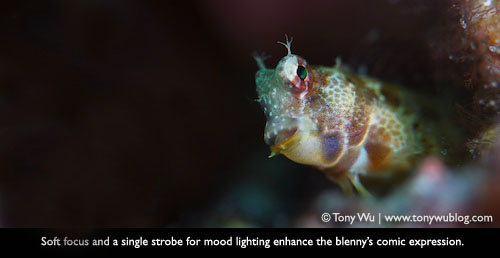 The effect that results from using f2.8 isn't ideal for everything. In fact, the circumstances in which you can pull off a 2.8 to 4 shot are probably quite limited. But the next time you find yourself in bad viz, consider giving it a try.
The effect that results from using f2.8 isn't ideal for everything. In fact, the circumstances in which you can pull off a 2.8 to 4 shot are probably quite limited. But the next time you find yourself in bad viz, consider giving it a try.
Remember to reduce your strobe power, crank the ISO down to 100 or less if you can, and make sure you avoid camera shake (unless you're intentionally introducing some blurring). One other trick is to try just using one strobe and fly in the face of the oft-quoted "you should always use two strobes" belief. If you've been shooting underwater for a while, these little tricks might add a nice new tool to your arsenal.
Never Land in a Circular Field
 It's difficult, no actually it's impossible, to relate the events and experiences of a month in PNG in a short post like this. I can think of dozens of other things I'd like to write about, but I'd probably end up boring you to death, assuming that you've even read this far.
It's difficult, no actually it's impossible, to relate the events and experiences of a month in PNG in a short post like this. I can think of dozens of other things I'd like to write about, but I'd probably end up boring you to death, assuming that you've even read this far.
I'll probably pick a few of the more interesting things to write about later, but for now, I'm going to wrap this post up with a final bit of trivia I picked up from ever-interesting Tim: Never land in a circular field.
 Apparently, this is a rule that glider pilots need to follow, because circular fields (in Australia at least) are watered by long poles that are fixed to the centre of the circle and revolve. So if you land in a circular field, you'll get bonked by the watering mechanism, which I take isn't generally recommended for gliders (we're talking glider planes, not hang gliders).
Apparently, this is a rule that glider pilots need to follow, because circular fields (in Australia at least) are watered by long poles that are fixed to the centre of the circle and revolve. So if you land in a circular field, you'll get bonked by the watering mechanism, which I take isn't generally recommended for gliders (we're talking glider planes, not hang gliders).
I'll probably never become a glider pilot, and surely this bit of information must rank among the least-likely-ever-to-be-useful-to-me things I've ever learned, but every time I think of it, I'll remember this trip and all the great people I met.
So maybe it's not so trivial after all.